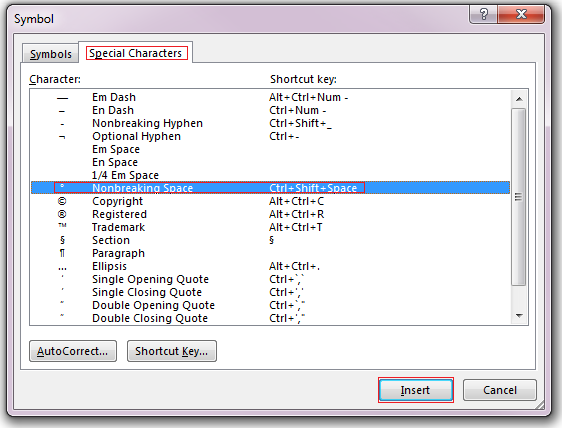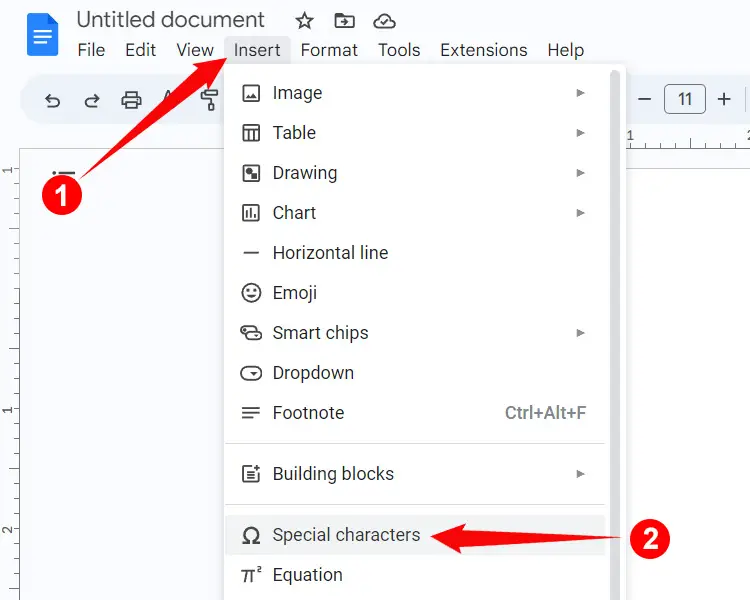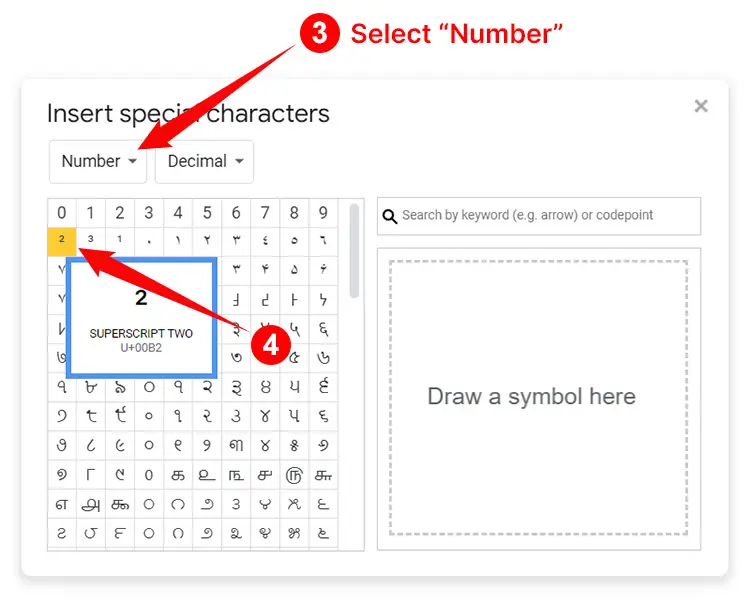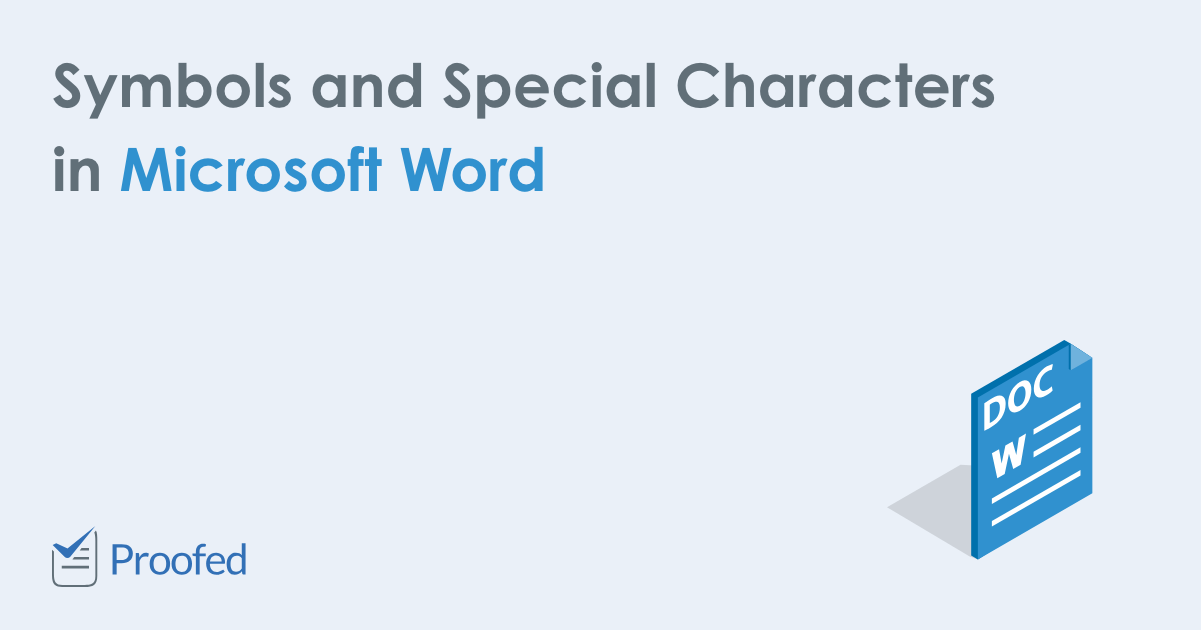Are you wondering how to type computer symbols using alt key on your keyboard? The following article will help you learn all that you need to know.
You must have noticed that your friends use different computer symbols and make their social networking site profile look really interesting. Many times, these symbols and meanings help you describe your feelings visually. Are you stuck with the usual 🙂 or 🙁 symbols and want to know more? You can learn to type symbols using alt key by simply hitting the right buttons.
Using the Alt Key
First, you need to find the numeric code that corresponds the symbol you want to use. Make sure the Num lock on the right side of your keyboard near the Num Pad is enabled. Then, press the Alt key button and type the code on Num Pad. You need to hold the Alt key button pressed and then enter the numeric code. The code needs to be entered only using Numeric Pad. After typing the code, release the Alt key. In case you need to type using a laptop, you may need to use the Function key (FN). You need to enable the Num Lock by pressing FN + Scroll Lock, and then hold the Alt key. Then, type in the number code for the particular symbol. If it is not working, you need to use FN + Alt. The following is a list with there meanings and corresponding number you need to type.
Computer Symbols and Meanings
| Number Code | Computer Symbol |
| 1 | ☺ |
| 2 | ☻ |
| 3 | ♥ |
| 4 | ♦ |
| 5 | ♣ |
| 6 | ♠ |
| 7 | • |
| 8 | ◘ |
| 9 | ○ |
| 10 | ◙ |
| 11 | ♂ |
| 12 | ♀ |
| 13 | ♪ |
| 14 | ♫ |
| 15 | ☼ |
| 16 | ► |
| 17 | ◄ |
| 18 | ↕ |
| 19 | ‼ |
| 20 | ¶ |
| 21 | § |
| 22 | ▬ |
| 23 | ↨ |
| 24 | ↑ |
| 25 | ↓ |
| 26 | → |
| 27 | ← |
| 28 | ∟ |
| 29 | ↔ |
| 30 | ▲ |
| 31 | ▼ |
| 32 | |
| 33 | ! |
| 34 | “ |
| 35 | # |
| 36 | $ |
| 37 | % |
| 38 | & |
| 39 | ‘ |
| 40 | ( |
| 41 | ) |
| 42 | * |
| 43 | + |
| 44 | , |
| 45 | – |
| 46 | . |
| 47 | / |
| 48 | 0 |
| 49 | 1 |
| 50 | 2 |
| 51 | 3 |
| 52 | 4 |
| 53 | 5 |
| 54 | 6 |
| 55 | 7 |
| 56 | 8 |
| 57 | 9 |
| 58 | : |
| 59 | ; |
| 60 | < |
| 61 | = |
| 62 | > |
| 63 | ? |
| 64 | @ |
| 65 | A |
| 66 | B |
| 67 | C |
| 68 | D |
| 69 | E |
| 70 | F |
| 71 | G |
| 72 | H |
| 73 | I |
| 74 | J |
| 75 | K |
| 76 | L |
| 77 | M |
| 78 | N |
| 79 | O |
| 80 | P |
| 81 | Q |
| 82 | R |
| 83 | S |
| 84 | T |
| 85 | U |
| 86 | V |
| 87 | W |
| 88 | X |
| 89 | Y |
| 90 | Z |
| 91 | [ |
| 92 | |
| 93 | ] |
| 94 | ^ |
| 95 | _ |
| 96 | ` |
| 97 | a |
| 98 | b |
| 99 | c |
| 100 | d |
| 101 | e |
| 102 | f |
| 103 | g |
| 104 | h |
| 105 | i |
| 106 | j |
| 107 | k |
| 108 | l |
| 109 | m |
| 110 | n |
| 111 | o |
| 112 | p |
| 113 | q |
| 114 | r |
| 115 | s |
| 116 | t |
| 117 | u |
| 118 | v |
| 119 | w |
| 120 | x |
| 121 | y |
| 122 | z |
| 123 | { |
| 124 | | |
| 125 | } |
| 126 | ~ |
| 127 | Δ |
| 0128 | € |
| 0130 | ‚ |
| 0131 | ƒ |
| 0132 | „ |
| 0133 | … |
| 0134 | † |
| 0135 | ‡ |
| 0136 | ˆ |
| 0137 | ‰ |
| 0138 | Š |
| 0139 | ‹ |
| 0140 | Π|
| 0142 | Ž |
| 0145 | ‘ |
| 0146 | ‘ |
| 0147 | “ |
| 0148 | “ |
| 0149 | • |
| 0150 | – |
| 0151 | – |
| 0152 | ˜ |
| 0153 | ™ |
| 0154 | š |
| 0155 | › |
| 0156 | œ |
| 0158 | ž |
| 0159 | Ÿ |
| 0160 | |
| 0161 | ¡ |
| 0162 | ¢ |
| 0163 | £ |
| 0164 | ¤ |
| 0165 | ¥ |
| 0166 | ¦ |
| 0167 | § |
| 0168 | ¨ |
| 0169 | © |
| 0170 | ª |
| 0171 | « |
| 0172 | ¬ |
| 0173 | |
| 0174 | ® |
| 0175 | ¯ |
| 0176 | ° |
| 0177 | ± |
| 0178 | ² |
| 0179 | ³ |
| 0180 | ´ |
| 0181 | µ |
| 0182 | ¶ |
| 0183 | · |
| 0184 | ¸ |
| 0185 | ¹ |
| 0186 | º |
| 0187 | » |
| 0188 | ¼ |
| 0189 | ½ |
| 0190 | ¾ |
| 0191 | ¿ |
| 0192 | À |
| 0193 | Á |
| 0194 | Â |
| 0195 | Ã |
| 0196 | Ä |
| 0197 | Å |
| 0198 | Æ |
| 0199 | Ç |
| 0200 | È |
| 0201 | É |
| 0202 | Ê |
| 0203 | Ë |
| 0204 | Ì |
| 0205 | Í |
| 0206 | Î |
| 0207 | Ï |
| 0208 | Ð |
| 0209 | Ñ |
| 0210 | Ò |
| 0211 | Ó |
| 0212 | Ô |
| 0213 | Õ |
| 0214 | Ö |
| 0215 | × |
| 0216 | Ø |
| 0217 | Ù |
| 0218 | Ú |
| 0219 | Û |
| 0220 | Ü |
| 0221 | Ý |
| 0222 | Þ |
| 0223 | ß |
| 0224 | à |
| 0225 | á |
| 0226 | â |
| 0227 | ã |
| 0228 | ä |
| 0229 | å |
| 0230 | æ |
| 0231 | ç |
| 0232 | è |
| 0233 | é |
| 0234 | ê |
| 0235 | ë |
| 0236 | ì |
| 0237 | í |
| 0238 | î |
| 0239 | ï |
| 0240 | ð |
| 0241 | ñ |
| 0242 | ò |
| 0243 | ó |
| 0244 | ô |
| 0245 | õ |
| 0246 | ö |
| 0247 | ÷ |
| 0248 | ø |
| 0249 | ù |
| 0250 | ú |
| 0251 | û |
| 0252 | ü |
| 0253 | ý |
| 0254 | þ |
| 0255 | ÿ |
This was the list that contains the number code and its corresponding computer symbol. All you need to do is look for the one you want and press the Alt key. Then on the Num Pad, type the corresponding number code and release the Alt key. Voila! You have your own personal symbol to express yourself. So, go ahead, type the symbols using Alt key in your word document and have fun creating an interesting document.
Get Updates Right to Your Inbox
Sign up to receive the latest and greatest articles from our site automatically each week (give or take)…right to your inbox.
Nowadays, communication language is changing and it becomes an old fashion to write everything using a clear text. From youngsters to elders, everyone is using symbols and shortcuts on daily basis. In our earlier articles, we have explained more than 600+ alt code shortcuts for Windows and option key shortcuts for Mac. In this article, let us show you 150+ alt code shortcuts for inserting computer and user interface symbols in Windows and Mac documents.
Do you ever know there is a symbol ⎀ for indicating inserted text in documents? Well, did you ever search for inserting command key symbol ⌘ in your Mac document? Unicode has thousands of symbols for different purposes including computer related symbols.
- We have checked all the below shortcuts in Windows 10 and 11 platforms on Microsoft 365 with Word and Excel apps.
- Mac supports only 4 digits hex code shortcuts and it will work on apps like Pages, Keynote and Numbers.
- If you see some of the interface symbols are not working on your document then try to change the font family.
- Remember, these symbols are similar to any other text content on your documents, hence you can increase or decrease font size and apply colors to them.
Alt Code Shortcuts for Computer and User Interface Symbols
Here is a complete list of computer related symbols that you can type using alt code keyboard shortcuts.
How to Use These Shortcuts?
There are different ways to use alt code shortcuts and if they are not working, you have other tools to find your favorite symbols.
Using Alt Codes in Windows PC
The “Alt + Decimal” shortcuts are the most popular in using desktop computers.
- Turn-on the NumLock key.
- Hold one of the alt keys on your keyboard.
- Enter the decimal code numbers using numeric pad.
- This will create the corresponding symbols.
For example, alt + 128193 will make the open folder symbol like 📂. You can do this on all the Windows based documents but you should have a separate number pad on the keyboard.
Using Hex Code in Word
The column “Hex Code, Alt + X” indicates the shortcuts for Microsoft Word. Enter the hexadecimal code and then press one of the alt keys and X to convert the hex code to a symbol. For example, 1F4C5 Alt + X will make the calendar symbol like 📅.
Using Symbol or Character Map Utility
If shortcuts are not working, you can Symbol utility in Office documents and Character Map in other applications. Follow the below steps, in order to use Symbol utility.
- Open Office document like Excel or Word.
- Go to “Insert > Symbol > More Symbols” menu.
- This will open Symbol utility.
- Change the font as “Wingdings” under “Symbols” tab.
- Search and insert computer related symbols.
- Here you can also find some good symbols like Microsoft Windows logo which you can’t type with keyboard shortcuts.

Other than Office applications, you can use Character Map app similar to Symbol utility.
Computer Emoji
There are also few computer related emoji symbols available. You can easily insert them on any document or chat conversation using emoji panel.
- Press “Win + Dot” keys to open emoji panel.
- Type “computer” to filter the relevant emoji.
- Click on the emoji to insert.

Insert Computer Symbols in Mac
Similar to Windows, you can use alt code and Character Viewer app in macOS.
Unicode Hex Method in Mac
- Change the input source to Unicode Hex Method.
- Hold one of the option or alt keys and type the 4 digit hexadecimal code from the above table.
For example, option + 2387 will produce the alternative or option key symbol ⎇.
Character Viewer App in Mac
The above method will only work with 4 digit codes and 5 digit hex codes will not work. Alternate option is to use Character Viewer app to insert computer and user interface symbols in Mac.
- Press “Command + Control + Space” to open Character Viewer app.
- Search the symbol name or hex code to filter the symbol.
- Double click on a symbol to insert on your document.

Word for Microsoft 365 Word 2021 Word 2019 Word 2016 Word 2013 Word 2010 Word Starter 2010 More…Less
You can easily insert a special character, fraction, or other symbol in your Word documents.
The most important thing to understand when inserting symbols, fractions, special characters, or international characters is that the font you use is critical. Not all fonts have the same characters in them. For example, the Elephant font has no fraction characters in it, while Verdana does. As a result it’s important to use the right font to find the symbol or character you want.
These marks are static symbols. If you’re looking for an interactive check box that you can click on to check or uncheck, see Make a checklist in Word.
Symbol such as currency (¥), music (♫), or check marks (✔)
-
Place your cursor in the file at the spot where you want to insert the symbol.
-
Go to Insert > Symbol.
-
Pick a symbol, or choose More Symbols.
-
Scroll up or down to find the symbol you want to insert.
Different font sets often have different symbols in them and the most commonly used symbols are in the Segoe UI Symbol font set. Use the Font selector above the symbol list to pick the font you want to browse through.
-
When you find the symbol you want, double-click it. The symbol will be inserted in your file.
-
Select Close.
Tip: If you want to make your symbol larger or smaller, select it and use the Font Size setting.
If you’re going to insert the same symbol often, consider setting up AutoCorrect to insert it for you. You can find more info about that here: Insert a check mark or other symbol using AutoCorrect.
-
Click or tap where you want to insert the special character.
-
Go to Insert > Symbol > More Symbols.
-
Go to Special Characters.
-
Double-click the character that you want to insert.
Tip: Many of the special characters have shortcut keys associated with them. If you want to insert that special character again in the future, just press the shortcut key. ALT+CTRL+C inserts the Copyright symbol (©), for example.
-
Select Close.
Some fractions (1/4, 1/2, and 3/4) automatically switch to a fraction character (¼, ½, ¾) when you type them. But others do not (1/3, 2/3, 1/5, etc.) so if you want to insert those as symbols you’ll need to use the insert symbol process.
-
Click or tapwhere you want to insert the fraction.
-
Go to Insert > Symbol > More Symbols.
-
In the Subset dropdown, choose Number Forms.
Note: Not all fonts have a number forms subset. If you don’t see the number forms subset available for your font you will have to use a different font, such as Calibri, to insert the fraction character.
-
Double-click the fraction that you want to insert.
-
Select Close.
Only a handful of common fractions have a symbol that you can substitute. For more unusual fractions, such as 8/9, you can approximate the symbol by setting the numerator as superscript and the denominator as subscript. For more information see Insert subscript or superscript text.
If you plan to type in other languages often you should consider switching your keyboard layout to that language. You can find more information about that at Enable or change a keyboard layout language.
For one-off characters there are almost always keyboard shortcuts in Office to do that. For example:
-
CTRL+SHIFT+ALT+? inserts a ¿
-
CTRL+SHIFT+~ followed immediately by «a» will insert ã.
-
CTRL+SHIFT+: followed immediately by «u» will insert ü.
For more info on international characters see: Keyboard shortcuts for international characters.
You can also use the character code of the symbol as a keyboard shortcut. Symbols and special characters are either inserted using ASCII or Unicode codes. You can tell which is which when you look up the code for the character.
-
Go to Insert >Symbol > More Symbols.
-
Scroll up or down the list to find the symbol you want. You might have to change the font or the subset to locate it.
Tip: The Segoe UI Symbol font has a very large collection of Unicode symbols to choose from.
-
Towards the bottom right you’ll see boxes for Character code and a from:. The character code is what you’ll enter to insert this symbol from the keyboard and the from: tells you what kind of character it is. If from: says «Unicode (hex)» it’s a Unicode character. If from: says «Symbol (Decimal)» then it’s an ASCII character.
Unicode

ASCII
ASCII and Unicode information and character tables
For more info about using ASCII or Unicode characters, see Insert ASCII or Unicode character codes.
Insert a check mark
For info on inserting a check mark, see Insert a check mark.
Need more help?
In algebra, “to square” is to multiply a number by itself. For example, the square of 5 is 25 because 5 multiplied by 5 equals 25. The square is one of the most common mathematical operations, but how do you write the squared symbol on your computer or mobile phone? Like many mathematical symbols, it’s hard to find in most keyboards.
In this article, we will teach you how to type the squared symbol on your computer or smartphone, be it on a word processor like Microsoft Word or in your emails and online conversations. You will be amazed at how easy it is to type the squared sign or symbol.
Table of Contents
- Copy and Paste the Squared Symbol
- How to Type the Squared Symbol on the Windows Keyboard
- How to Type the Squared Symbol on the Mac Keyboard
- How to Type the Squared Symbol in Microsoft Word
- How to Type the Squared Symbol in Google Docs
- How to Type the Squared Symbol on Android
- How to Type the Squared Symbol on the iPhone or iPad
- How to Insert the Squared Sign Using the Character Map
- Wrapping Up
Copy and Paste the Squared Symbol
If you can’t be bothered to type the squared symbol manually, you can just copy it from this page. All you have to do is to click the box below and the squared sign will be instantly copied to your clipboard, ready for pasting into your document.
Paste your copied symbol into your document or application by right-clicking and selecting Paste. You can also tap Ctrl + V to paste it. If you’re on mobile, just long-press and select Paste.
How to Type the Squared Symbol on the Windows Keyboard
The easiest way to type the squared symbol is by holding the Alt key while typing 0178 on the number pad. Make sure that Num Lock is turned on for this keyboard shortcut to work. Typing the keyboard shortcut using the number keys above the letters (outside the number pad) will not work – you must use the number pad on the right side of the keyboard.
So the keyboard shortcut for the squared symbol is Alt + 0178. The result is like this: ².
Here’s the step-by-step procedure on how to type the squared symbol using a Windows keyboard:
- Place the cursor or insertion point where you want the squared symbol to appear in your document or application.
- Activate the numeric keypad or number pad by tapping the Num Lock key.
- Press and hold the Alt key.
- While pressing the Alt key, type the 0178 keys on the numeric keypad.
- Check the correct symbol has been inserted into your document.
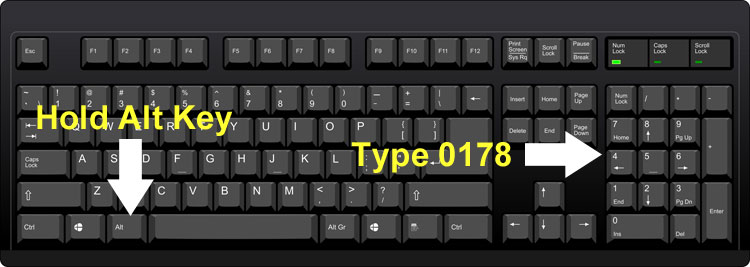
The beauty of this method is that it works for almost any application including Notepad, Google Chrome and Microsoft Word. As long as your keyboard has a numeric keypad or number pad, you can type the squared sign via the keyboard shortcut. But if your keyboard doesn’t have a numeric keypad, you can insert the squared symbol by copying the symbol from this page or by using the Character Map.
Unlike Windows, there’s no universal shortcut for typing the squared symbol on Mac computers. However, you can use the Character Viewer in macOS to insert symbols, emojis and special characters.
Follow these steps to insert the squared symbol in Mac:
- In your application, open the Character Viewer by selecting Edit > Emoji & Symbols.
- Enter “superscript” in the search field and tap Enter.
- Click the superscript 2 to insert the squared symbol.
How to Type the Squared Symbol in Microsoft Word
Many of us use Microsoft Word and other word processing software to draft our documents and correspondences. These word processors have support for special characters like the superscript symbol (x²).
To type the squared symbol on Microsoft Word, click the superscript button (x²) in the Font group under the Home tab, and then type the number 2. You can also type 2 first and then select or highlight it before clicking the x² button.
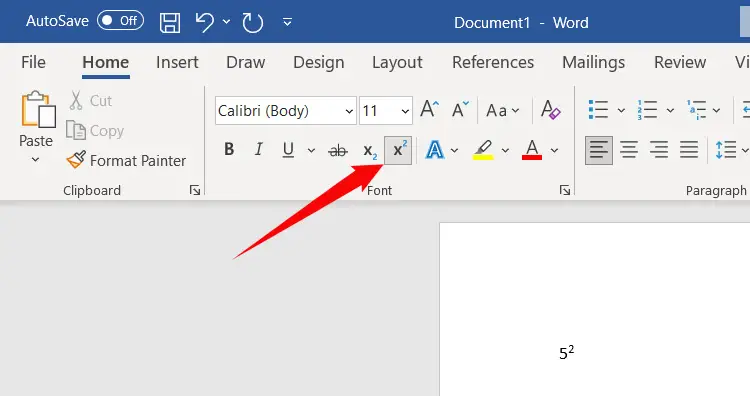
Alternatively, you can use the keyboard shortcut Ctrl + Shift + + (hold the Ctrl and Shift keys and then press the + key) to get the same result as clicking x². Take note that this keyboard shortcut only works on Word. Using it on the Chrome browser will zoom the window instead, so be careful with this.
How to Type the Squared Symbol in Google Docs
Google Docs is a free web-based alternative to Microsoft Word. Just like Word, Google Docs offers a quick and convenient way to type superscript characters.
To type the squared symbol in Google Docs using a keyboard shortcut, just press Ctrl + . (dot or period key), and then type the number 2. The superscript ² will then appear in your document.
You can also insert the squared symbol in Google Docs by following these steps:
- Click Insert on the menu bar.
- Select Special characters on the dropdown menu.
- On the “Insert special characters” dialog, click the Symbol field and choose “Number.” Make sure that the second dropdown field is set to “Decimal.”
- Find the “superscript two” symbol and click it.
- Check that the correct symbol has been inserted into your document.
If you have trouble locating the squared sign, you can search for it by typing “superscript two” in the “Search by keyword” field on the right.
How to Type the Squared Symbol on Android
Inserting the squared symbol on your Android smartphone is relatively easy and straightforward. To insert the squared sign, just long-press the number 2 and it will insert the superscript ².
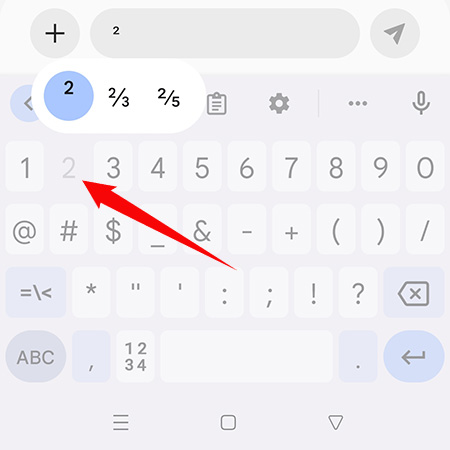
How to Type the Squared Symbol on the iPhone or iPad
Unfortunately, the iPhone keyboard doesn’t have the option to insert the squared symbol. You can use the dictation feature on your iPhone instead. Tap the dictation microphone on the iOS keyboard and then say the words “superscript two.” Press “Done” or tap the keyboard icon when you get the correct symbol.
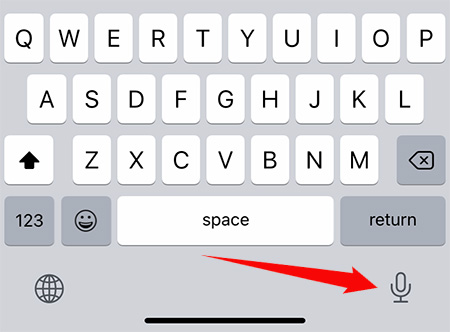
How to Insert the Squared Sign Using the Character Map
The Character Map application is a great tool for copying and inserting numerous characters and symbols. You can use this Windows tool if your keyboard doesn’t have a number pad or if you just want a quick and convenient way to insert the squared symbol.
To start, click the Windows icon on the bottom left corner of the screen, go to Windows Accessories, and then click Character Map. Choose the superscript 2 button, click Select and then Copy. You can now paste the symbol into any application.
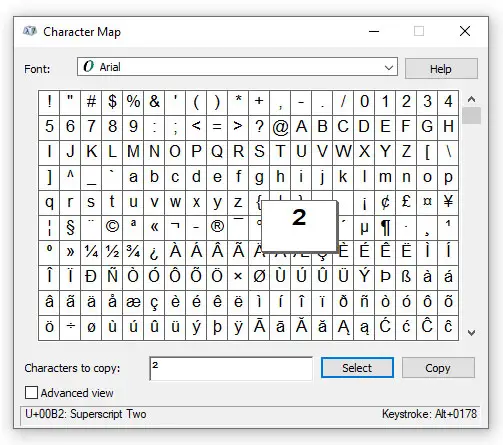
Wrapping Up
If everything fails, you can simply copy the squared symbol from this page and paste it anywhere you want. Highlight this symbol: ² and then press Ctrl and C simultaneously to copy it. Go back to your document or application, and then paste the symbol by pressing Ctrl and V at the same time. You can also right-click using your mouse and select Copy and Paste.
That’s it! It’s super easy to type the squared sign for use in mathematical equations. Remember, you can always copy and paste this symbol if you’re having difficulties.
Your average keyboard has enough letters, numbers, and punctuation marks for all your day-to-day typing needs. But what if you need symbols or special characters that aren’t on your keyboard?
Well, in Microsoft Word, you have three main options:
- Use the Symbol menu.
- Learn some ASCII codes.
- Use Microsoft Word’s special character shortcuts.
In the rest of this post, we’ll look at how to do each of these in your writing. Watch the video or read the post below to get started:
1. Using the Symbol Menu
To see the Symbol menu in Microsoft Word, go to Insert > Symbols on the ribbon and click the Symbol button (or Insert > Advanced Symbol > Symbols in the menu system in Word for Mac).

This will open a quick access menu of 20 frequently used symbols to pick from. However, you can also access the full range of special characters in Microsoft Word as follows:
- Go to Insert > Symbols and click Symbol to open the menu.
- Click More Symbols… to open a new window.
- Scroll through until you find the symbol you want to use.
- Click Insert to add the symbol to your document.
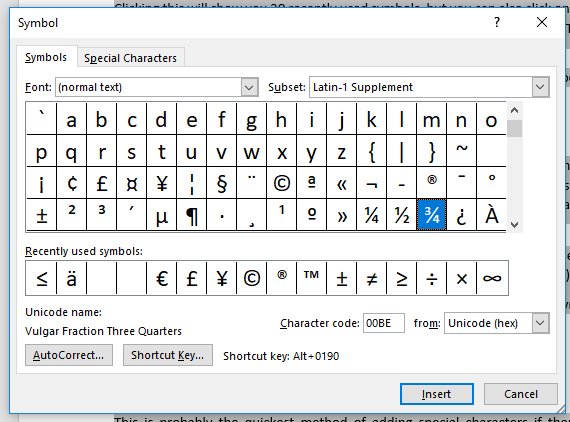
The symbol will then appear in your document at your cursor. Microsoft Word will also add it to the quick access menu, saving your time if you need to use the same symbol again.
2. ASCII Codes
ASCII codes each indicate a different symbol, so you can use them to add special characters to a document quickly via the numeric keypad:
- Learn or look up the correct ASCII code for the symbol(s) you need.
- Turn on Num Lock on your keyboard to activate the numeric keypad.
- Hold down the Alt key and type the required code.
The corresponding symbol will then appear at your cursor position.
3. Shortcuts for Special Characters
For some special characters, your simplest option is to let Microsoft Word do the hard work! There are, for example, shortcuts available for the following common symbols:
|
Special Character |
Shortcut |
Autocorrect Option |
|
Trademark symbol (™) |
Ctrl + Alt + T |
Write “TM” in parentheses |
|
Registered trademark symbol (®) |
Ctrl + Alt + R |
“R” in parentheses |
|
Copyright symbol (©) |
Ctrl + Alt + C |
“C” in parentheses |
|
Closed Ellipsis (…) |
Ctrl + Alt + . |
Three periods without spaces |
|
Euro (€) |
Ctrl + Alt + E |
“E” in parentheses |
You’ll notice we’ve included an “autocorrect” version for each symbol above. In these cases, Microsoft Word will automatically correct the specified text to create the symbol.
Find this useful?
Subscribe to our newsletter and get writing tips from our editors straight to your inbox.
For example, to add a trademark symbol to a document, we have two options:
- Hold down Ctrl + Alt + T at the same time.
- Write “(TM)” and let Microsoft Word change this to the symbol.
These shortcuts are very quick and simple, so it is worth memorizing them if you use any of these symbols frequently. Similar shortcuts are also available for accented letters.



